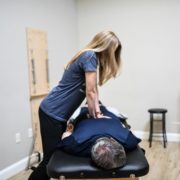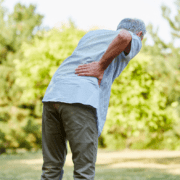Exercise-induced Leg Soreness or Sciatica? How to Tell the Difference.
It’s that time of year – when people set goals and take action to improve their health, get back in shape, and ramp up exercise routines.
But what happens when your body isn’t ready for what your mind has planned? How can you tell if the soreness you feel is “good pain” – or a problem brewing?
This concept is particularly confusing when it comes to leg pain. Whether it’s ramping up your strength training, more frequent Peloton rides, or getting back to running/jogging… These activities will make your legs sore. The problem, however, is that leg soreness can mimic a common (and sneaky) condition called “sciatica” – that if missed or ignored – could completely derail you from your health and fitness goals. So it’s important you know the difference and what to watch out for – especially if you have a history of sciatica or back pain.
Here are some key things you to look out for – that will help you tell the difference between normal leg soreness from exercise – versus sciatic pain that’s caused from your back:
Exercise-induced leg soreness…
With exercise-induced leg soreness – you’ll typically feel pain deep in your muscles (especially those you specifically worked on) – and your legs may feel tender to touch or even “swollen”. This type of soreness comes from challenging your muscles beyond their usual capacity – something you want to do during exercise. The soreness is caused by microscopic damage to your muscle fibers – triggering an inflammatory response. This inflammatory response then triggers a repair phase in the area of the “damaged tissue” (aka your muscles). It’s in this repair phase that your body builds back stronger muscles – so that they’re more resilient the next time you exercise.
Another key characteristic of exercise-induced leg soreness is that it will typically occur anywhere from 24-72 hours after the activity. This phenomenon is known as “DOMS” (delayed onset muscle soreness) and it will usually dissipate in a similar amount of time. The soreness you feel from DOMS is often felt symmetrically (in both legs) – because most exercises are done using both sides of your body. But even if you’ve done an activity that favors one leg over another – the pain you experience during the DOMS period will occur when you’re moving or stretching the affected muscles – and not so much during periods of rest.
Now let’s look at sciatica…
Sciatica is a problem that comes from your spine and that causes pain in your buttock and/or leg. In between each vertebrae (the bones that make up your spine) are small spaces that allow the nerves originating from your spinal cord to exit. These nerves control everything from sensation, to pain, to muscle strength. If the nerves in your lower back get irritated – or structures around those nerves get irritated (for example, bulging discs) – anything in your leg (or butt) that those irritated nerves “touch” can also be affected. This is the phenomenon known as sciatica.
The tricky part about sciatica is that the timeline of your pain – and the feeling you experience – can be very similar to the leg soreness you get from exercise. Just like exercise-induced leg soreness – sciatic pain can include a deep ache in your muscles, tenderness to touch, and a feeling of swelling. People often describe to me a feeling of “heaviness” in their leg when they are experiencing a sciatic episode. Sciatic pain can also come on 24-72 hours after exercising or activity.
But with sciatica – one of the most important factors you need to pay attention to is how your pain behaves. Leg soreness from exercise arrives in a fairly predictable manner – and leaves in a fairly predictable manner. And you generally won’t have much pain at rest.
Sciatica, on the other hand, is more unpredictable.
Although it can come on in the same time frame as exercise-induced leg soreness – it won’t just “go away” in the same, predictable amount of time. Pain from sciatica can linger – particularly at rest – and with activities such as sitting, driving, standing too long, or walking. It can end up in just one leg even though it started in both – and it tends to come and go. For example – you’ll think it’s better – only to suddenly wake up with a sore leg again – or bend the wrong way and have the pain annoyingly return. And finally – sciatic pain won’t go away completely with stretching or massage (although it’s tempting to think it did).
But one of the most important things to notice about the behavior of sciatic pain versus exercise-induced leg pain is whether or not numbness or tingling is present. It’s possible to have sciatic pain without numbness and tingling – but it’s not possible to have it with healthy, exercise-induced leg soreness. That’s because only nerve irritation can cause the sensation of numbness and tingling in your leg. And speaking of nerve irritation… If your leg soreness “goes away” – but you’re left with a lingering back ache – your leg pain was almost certainly a sciatic episode that has temporarily resolved – and it’s only a matter of time before it returns with a vengeance.
So there you have it – next time you notice leg pain after exercising – pay attention to how your pain behaves.
How long does it last? Does it come and go? Is it only in one leg vs both? Do you have any numbness? Does it linger or return with mundane activities such as sitting or standing? If the answer to any of these questions is “yes” – and especially if you’ve got a history of back pain – you must consider that it could be sciatica. To make sure – seek out the help of a mechanical back pain specialist who can tell you for certain.
Dr. Carrie Jose, Physical Therapy Specialist, and Mechanical Pain Expert, owns CJ Physical Therapy & Pilates in Portsmouth, NH, and writes for Seacoast Media Group. If local to Portsmouth, NH, and looking for help – request a FREE Discovery Visit with one of her Specialists by CLICKING HERE.










